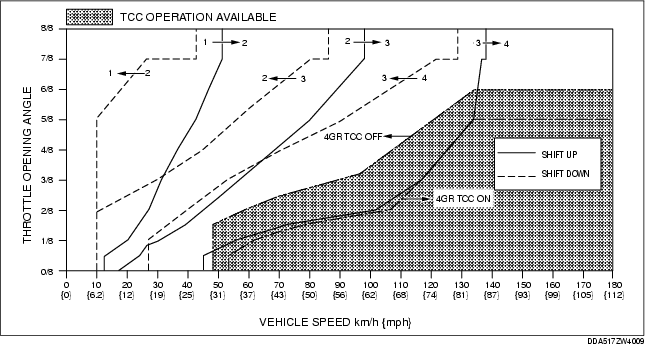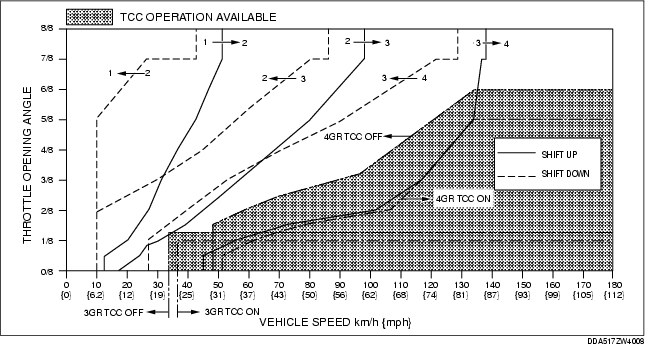ROAD TEST [FN4A-EL]
id0517a1802200
-
Warning
-
• When performing a road test, be aware of other vehicles, people, impediments, etc. to avoid an accident.
-
Note
-
• When the legal speed limit must be exceeded, use a chassis dynamometer instead of performing a road test.
Road Test Preparation
1. Inspect the engine coolant levels. (See ENGINE COOLANT LEVEL INSPECTION [ZY].)
2. Inspect the engine oil levels. (See ENGINE OIL LEVEL INSPECTION [ZY].)
3. Inspect the ATF levels. (See AUTOMATIC TRANSAXLE FLUID (ATF) INSPECTION [FN4A-EL].)
4. Inspect the idle speed and ignition timing in P position. (See IDLE SPEED INSPECTION [ZY].) (See IGNITION TIMING INSPECTION [ZY].)
5. Bring up the engine and transaxle to normal operating temperature.
Shift Diagram
D range (normal mode)
Australian specs. (Sport AT)

General (R.H.D.) specs. (Sport AT, 4AT)

D Range Test
1. Perform road test preparation. (See Road Test Preparation.)
2. Shift the selector lever to D range.
3. Accelerate the vehicle with half and WOT, then verify that 1→ 2, 2→ 3, and 3→ 4 upshifts can be obtained. The shift points must be as shown in the table below.
-
• If there is any malfunction, inspect the PCM and ATX. (See SYMPTOM TROUBLESHOOTING ITEM TABLE [FN4A-EL].)
4. Drive the vehicle in 4GR, 3GR, and 2GR and verify that kickdown occurs for 4→ 3, 3→ 2, 2→ 1 downshifts, and that the shift points are as shown in the table below.
-
• If there is any malfunction, inspect the PCM and ATX. (See SYMPTOM TROUBLESHOOTING ITEM TABLE [FN4A-EL].)
5. Decelerate the vehicle and verify that engine braking effect is felt in 2GR, 3GR, and 4GR.
-
• If there is any malfunction, inspect the PCM and ATX. (See SYMPTOM TROUBLESHOOTING ITEM TABLE [FN4A-EL].)
6. Drive the vehicle and verify that TCC operation is obtained. The operation points must be as shown in the table below.
-
• If there is any malfunction, inspect the PCM and ATX. (See SYMPTOM TROUBLESHOOTING ITEM TABLE [FN4A-EL].)
7. Select HOLD mode. (4AT)
8. Accelerate the vehicle at half throttle and WOT, and verify that 4→ 3, 3→ 2, and 2→ 3 shift can be obtained. The shift points must be as shown in the table below. (4AT)
-
• If there is any malfunction, inspect the PCM and ATX. (See SYMPTOM TROUBLESHOOTING ITEM TABLE [FN4A-EL].)
9. Drive the vehicle in 4GR, 3GR, 2GR and verify that kickdown does not occur. (4AT)
-
• If there is any malfunction, inspect the PCM and ATX. (See SYMPTOM TROUBLESHOOTING ITEM TABLE [FN4A-EL].)
10. Decelerate the vehicle and verify that engine braking effect is felt in 2GR, 3GR, and 4GR. (4AT)
-
• If there is any malfunction, inspect the PCM and ATX. (See SYMPTOM TROUBLESHOOTING ITEM TABLE [FN4A-EL].)
Shift point table
|
Range/Mode
|
Throttle condition
|
Shift
|
Vehicle speed
(km/h {mph})
|
Turbine speed
(rpm)
|
|
D
|
NORMAL
|
WOT
|
D1→ D2
|
50-56 {31-34}
|
5,500-6,150
|
|
D2→ D3
|
96-104 {60-64}
|
5,850-6,300
|
|
D3→ D4
|
135-145 {84-89}
|
5,300-5,650
|
|
Half throttle
|
D1→ D2
|
33-40 {21-24}
|
3,550-4,450
|
|
D2→ D3
|
60-77 {38-47}
|
3,650-4,650
|
|
D3→ D4
|
115-136 {72-84}
|
4,500-5,300
|
|
TCC ON (D4)
|
115-136 {72-84}
|
3,150-3,700
|
|
CTP
|
D4→ D3
|
24-30 {15-18}
|
700-800
|
|
D3→ D1
|
7-13 {5-8}
|
300-500
|
|
Kickdown (WOT)
|
D4→ D3
|
124-134 {77-83}
|
3,400-3,600
|
|
D3→ D2
|
82-90 {51-55}
|
3,250-3,500
|
|
D2→ D1
|
39-45 {25-27}
|
2,400-2,700
|
|
POWER
|
WOT
|
D1→ D2
|
50-56 {31-34}
|
5,500-6,150
|
|
D2→ D3
|
96-104 {60-64}
|
5,850-6,300
|
|
D3→ D4
|
135-145 {84-89}
|
5,300-5,650
|
|
Half throttle
|
D1→ D2
|
36-45 {23-27}
|
3,950-4,950
|
|
D2→ D3
|
71-86 {45-53}
|
4,300-5,250
|
|
D3→ D4
|
121-141 {76-86}
|
4,750-5,500
|
|
CTP
|
D4→ D3
|
26-32 {17-19}
|
750-850
|
|
D3→ D1
|
9-15 {6-9}
|
400-550
|
|
Kickdown (WOT)
|
D4→ D3
|
124-134 {77-83}
|
3,400-3,600
|
|
D3→ D2
|
82-90 {51-55}
|
3,250-3,500
|
|
D2→ D1
|
39-45 {25-27}
|
2,400-2,700
|
|
HOLD*
|
ALL round
|
D2→ D3
|
15-25 {10-15}
|
950-1,500
|
|
D4→ D3
|
135-141 {84-87}
|
3,700-3,800
|
|
D3→ D2
|
7-13 {5-8}
|
300-500
|
-
* :
4AT
M Range Test (Sport AT)
1. Perform road test preparation. (See Road Test Preparation.)
2. Shift the selector lever to M range.
3. Verify that 1→ 2, 2→ 3, and 3→ 4 upshifts and 4→ 3, 3→ 2, and 2→ 1 downshifts are obtained by manual shifting of the selector lever forward and back.
-
• If there is any malfunction, inspect the PCM and ATX. (See SYMPTOM TROUBLESHOOTING ITEM TABLE [FN4A-EL].)
4. Decelerate the vehicle and verify that 4→ 3, 3→ 2, 2→ 1downshifts are obtained. The shift points must be as shown in the table below.
-
• If there is any malfunction, inspect the PCM and ATX. (See SYMPTOM TROUBLESHOOTING ITEM TABLE [FN4A-EL].)
5. Decelerate the vehicle and verify that engine braking effect is felt in all gears.
-
• If there is any malfunction, inspect the PCM and ATX. (See SYMPTOM TROUBLESHOOTING ITEM TABLE [FN4A-EL].)
Vehicle speed at shift point table
|
Range
|
Mode
|
Throttle condition
|
Shift
|
Vehicle speed
km/h {mph}
|
Turbine speed
(rpm)
|
|
M
|
Manual
|
All round
|
M4→ M3
|
27-33 {17-20}
|
750-850
|
|
M3→ M2
|
5-11 {4-6}
|
200-400
|
|
M2→ M1
|
5-11 {4-6}
|
350-650
|
S Range Test (4AT)
1. Perform road test preparation. (See Road Test Preparation.)
2. Shift the selector lever to S range.
3. Accelerate the vehicle at half throttle and WOT, then verify that 1→ 2 and 2→ 3 upshifts can be obtained. The shift points must be as shown in the table below.
-
• If there is any malfunction, inspect the PCM and ATX. (See SYMPTOM TROUBLESHOOTING ITEM TABLE [FN4A-EL].)
4. Drive the vehicle in 2GR, 3GR, 4GR and verify that kickdown occurs for 4→ 3, 3→ 2, 2→ 1 downshift, and that the shift point is as shown in the table below.
-
• If there is any malfunction, inspect the PCM and ATX. (See SYMPTOM TROUBLESHOOTING ITEM TABLE [FN4A-EL].)
5. Decelerate the vehicle and verify that engine braking effect is felt in 2GR, 3GR and 4GR.
-
• If there is any malfunction, inspect the PCM and ATX. (See SYMPTOM TROUBLESHOOTING ITEM TABLE [FN4A-EL].)
6. Select HOLD mode.
7. Accelerate the vehicle in 2GR at half throttle and WOT, and verify that 2GR is held.
-
• If there is any malfunction, inspect the PCM and ATX. (See SYMPTOM TROUBLESHOOTING ITEM TABLE [FN4A-EL].)
8. Decelerate the vehicle and verify that engine braking effect is felt.
-
• If there is any malfunction, inspect the PCM and ATX. (See SYMPTOM TROUBLESHOOTING ITEM TABLE [FN4A-EL].)
Shift point table
|
Range/
Mode
|
Throttle condition
|
Shift
|
Vehicle speed
(km/h {mph})
|
Turbine speed
(rpm)
|
|
S
|
NORMAL
|
WOT
|
S1→ S2
|
50-56 {31-34}
|
5,500-6,150
|
|
S2→ S3
|
96-104 {60-64}
|
5,850-6,300
|
|
Half throttle
|
S1→ S2
|
36-45 {23-27}
|
3,950-4,950
|
|
S2→ S3
|
71-86 {45-53}
|
4,300-5,250
|
|
CTP
|
S4→ S3
|
135-141 {84-87}
|
3,700-3,800
|
|
S3→ S1
|
9-15 {6-9}
|
400-550
|
|
Kickdown (WOT)
|
S3→ S2
|
82-90 {51-55}
|
3,250-3,500
|
|
S2→ S1
|
39-45 {25-27}
|
2,400-2,700
|
|
HOLD
|
ALL round
|
S4→ S3
|
135-141 {84-87}
|
3,700-3,800
|
|
S3→ S2
|
95-101 {59-62}
|
3,750-3,900
|
L Range Test (4AT)
1. Perform road test preparation. (See Road Test Preparation.)
2. Shift the selector lever to L range.
3. Accelerate the vehicle at half throttle and WOT, then verify that 1→ 2 upshift. The shift points must be as shown in the table below.
-
• If there is any malfunction, inspect the PCM and ATX. (See SYMPTOM TROUBLESHOOTING ITEM TABLE [FN4A-EL].)
4. Drive the vehicle in 2GR and verify that kickdown occurs for 2→ 1 downshift, and that the shift point is as shown in the table below.
-
• If there is any malfunction, inspect the PCM and ATX. (See SYMPTOM TROUBLESHOOTING ITEM TABLE [FN4A-EL].)
5. Decelerate the vehicle and verify that engine braking effect is felt in 1GR,2GR, 3GR and 4GR.
-
• If there is any malfunction, inspect the PCM and ATX. (See SYMPTOM TROUBLESHOOTING ITEM TABLE [FN4A-EL].)
6. Select HOLD mode.
7. Accelerate the vehicle in 1GR at half throttle and WOT, and verify that 1GR is held.
-
• If there is any malfunction, inspect the PCM and ATX. (See SYMPTOM TROUBLESHOOTING ITEM TABLE [FN4A-EL].)
8. Decelerate the vehicle and verify that engine braking effect is felt.
-
• If there is any malfunction, inspect the PCM and ATX. (See SYMPTOM TROUBLESHOOTING ITEM TABLE [FN4A-EL].)
Shift point table
|
Range/Mode
|
Throttle condition
|
Shift
|
Vehicle speed
(km/h {mph})
|
Turbine speed
(rpm)
|
|
L
|
NORMAL
|
WOT
|
L1→ L2
|
50-56 {31-34}
|
5,500-6,150
|
|
Half throttle
|
L1→ L2
|
36-45 {23-27}
|
3,950-4,950
|
|
CTP
|
L4→ L3
|
135-141 {84-87}
|
3,700-3,800
|
|
L3→ L2
|
95-101 {59-62}
|
3,750-3,900
|
|
L2→ L1
|
9-15 {6-9}
|
550-900
|
|
Kickdown (WOT)
|
L2→ L1
|
39-45 {25-27}
|
2,400-2,700
|
|
HOLD
|
ALL round
|
L4→ L3
|
135-141 {84-87}
|
3,700-3,800
|
|
L3→ L2
|
95-101 {59-62}
|
3,750-3,900
|
|
L2→ L1
|
39-45 {25-27}
|
2,400-2,700
|
P Position Test
1. Shift into P position on a gentle slope. Release the brake and verify that the vehicle does not roll.


